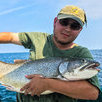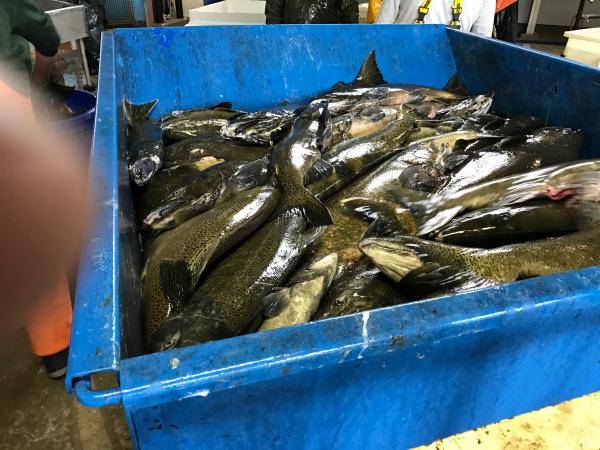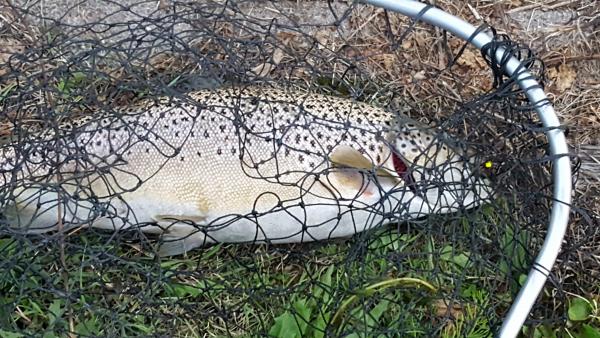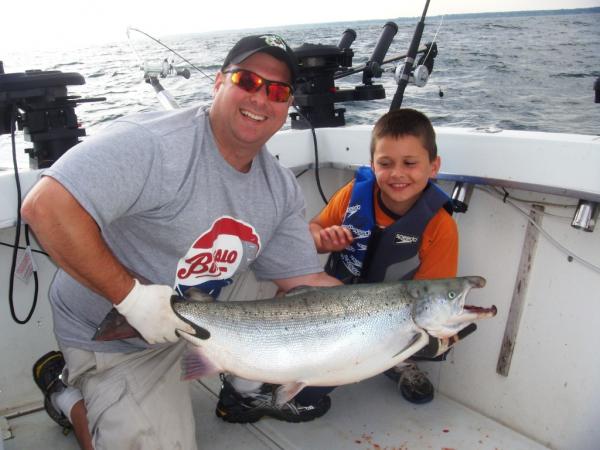-
Posts
177 -
Joined
-
Last visited
Everything posted by Char_Master
-
Similar thing going on in my boat now. We have two rigger rods and two wire diver rods. Ran two 10 color lead rods with inline boards this season but the stiff rod necessary for inline boards and that much inline weight made fighting fish on those rods not nearly as enjoyable. Next season I plan on either adding another two downriggers to get four of them going (since Riggers catch 80% of all our fish) or get a couple of rods for super-heavy snap weights to use as shallow(er) setups off the inline boards. If you're going for leadcore then I'd recommend possibly doing external boards to avoid more weight than necessary on the line when fighting fish.
-
lol, adult GBL Redfins would probably try to eat the Chinooks haha! Ever read in to what those things eat in that lake with only 4-5 species of fish present? Most of their diet is made up of fully grown Arctic Greyling and Whitefish and the larger individuals will cannibalize on 8-16 pound Lakers like they're appetizers. Maybe that's exactly what the Lake O community would like, a bigger strain of Lake Trout that fight even harder (they are the Kings in my eyes ) and additionally will lessen the population size by eating smaller ones. Although, I can see it now, a 50" Redfin relentlessly chasing schools of 2-3 year old salmon like they were baitfish XD
-
-
That's another good theory. I believe almost all of the Salmonid hybrids are sterile, but I could be wrong. Caught a "Pinook" last July in eastern Lake Erie but other than that I haven't personally encountered any hybrids. Wonder how big Skeena chrome would get in the environment of Lake Ontario, certainly it would have to be larger than the domestic "Rainbow" strain Steelhead. Seaforellens would be great too, which, being a deeper strain, would make great bonus fish for guys deep trolling for Steelhead, Chinooks, and Lakers.
-

A discussion worth having. Gene Editing
Char_Master replied to Sea Lion's topic in Open Lake Discussion
Georgian Bay was also, and still is, Lake Huron's largest stronghold of native strain Lake Trout too, so my guess would be that either the forage base and or water conditions in it allow for a multitude of species to thrive. I do have to agree with you here though, at least in Lake Ontario, Chinooks will most likely be around for longer than they will be in the other lakes. Where would you suggest that these funds that Canada is using to restore Atlantic Salmon go instead? Canada is making greater progress with this program over the past several years and as long as efforts are maintained, I predict there will be an Atlantic Salmon fishery (at least in Canadian tributaries) available to anglers within the next 8-15 years. If this fishery does take form, it will likely attract many anglers to it who wish to pursue one of the most revered fish in the world. The reason that so many people flock to NY for Chinooks and Steelhead is because of tradition, it's been a thriving fishery for decades now and so obviously anglers would be attracted to it and want to protect it. A switch from Chinooks to Atlantics, regardless of how gradual, would be a major change in the fishery which is why I think many anglers are hesitant to support it. As far as favoring native species over introduced ones, there's been debates over this for years and there will continue to be. Personally, I feel that humans have the responsibility to protect native species due to all the unnatural damage and changes that we cause in the environment where thousands of other species that can't do anything to protect themselves from these changes also reside. I think that native species have a natural right to exist that humans shouldn't be depriving entire populations of fish of (I'll stop with the philosophy now ). That said, I can also see the social and economic benefits that certain introduced species have as well, so I'm not fully against all introduced/invasive species. Now, speaking from my personal perspective instead of a more scientific one. I'd gladly make the 5.5-6 hour drive to the Salmon River several times in a season if Atlantics were in fishable numbers, and will make it up to troll the lake two or three times a year primarily for Lake Trout (with Steelhead and Browns on the side), but not solely for Chinook Salmon. So obviously someone enjoys and appreciates Lakers and Atlantics . And I have a few friends that think the same way too. -
-

Fall Browns
Char_Master replied to Sam N. Slayer's topic in New York Fishing Reports - Lake Ontario (South Shore)
Couldn't agree with you more here. It's like that on Erie too in the fall along creek mouths. Whenever I catch Salmonids, trolling of drifting, 10 FOW or 550 FOW, I always take at least 3-5 minutes holding them in the water before the release. Certain species seem tougher than others, Lake Trout are usually trying to drag me in with them within 30-60 seconds whereas steelhead swim away slow but stable after 4-5 minutes or longer, but eventually they all go back down if handled correctly (as in, netted, unhooked in the water, quickly measure length and girth, hold the fish correctly by the caudal peduncle and under the stomach horizontally for some quick pictures, revive, and release). The two biggest detriments to be health of these fish are too long out of the water and improper handling. If you're going to C&R, that is. -
-

A discussion worth having. Gene Editing
Char_Master replied to Sea Lion's topic in Open Lake Discussion
Fleas too, that's interesting, I'll have to look further in to that. Thank you for more information, I appreciate it! I will say that Chinooks are doing better in Lake Ontario than any of the other Great Lakes, arguably even better than Lake Trout. But if you look to the midwest's upper Great Lakes, things are changing. Lake Michigan's Chinook population is dwindling while Steelhead, Browns, and Lakers are increasing in abundance. In Lake Huron, Chinooks are almost absent with Lake Trout and Atlantic Salmon populations increasing. And in Superior, Chinooks might as well be gone completely, for as often as they're actually caught, instead what is present is almost without a doubt the best native Lake Trout fishery in the United States with small but stable populations of Steelhead, Coho Salmon, and Pink Salmon. Whether Lake Ontario will follow this trend remains to be seen, but this is just what's happening in the upper lakes and what I predict will also occur in the lower ones too. -

A discussion worth having. Gene Editing
Char_Master replied to Sea Lion's topic in Open Lake Discussion
I'd much rather have it available as forage species, no question about that. However, I don't think it's worth the potential consequences to attempt to gene edit the mussels, which is why I'm saying make the best of our current situation. -

A discussion worth having. Gene Editing
Char_Master replied to Sea Lion's topic in Open Lake Discussion
What are some of the other dominant forage species you've seen they consume? The past several GLFC and fisheries reports I've read seem to point to Chinooks being the least diverse feeders for one reason or another. As far as Lake Trout are concerned, I'd like to see them at historic highs to the point where the population is what is used to be and is completely naturally producing. They're also a native species that has shown to be much more adaptable to a diverse forage base such as Round Gobies, Sculpins, Smelt, and Ciscos and with shifting water conditions. Personally, I'd rather catch Lake Trout than Chinooks, but that's completely beside the point, being which species are more adaptable. This is still pertaining to the topic which branches off of whether it's worth the risk to the entire system to attempt to edit the genes of zebra mussels, which I do not believe it is. -

A discussion worth having. Gene Editing
Char_Master replied to Sea Lion's topic in Open Lake Discussion
Yes, I am. First Chinooks and eventually Cohos. Steelhead and Pinks do appear to be doing fine, though, so they'll likely be around for much longer. It's no surprise, the Chinook is a native of the Pacific Ocean, emphasis on ocean, which has an abundant and diverse forage base to support the species. They thrived in the Great Lakes when alewives were at their peak, and quite honestly I think their initial introduction turned out to be quite successful in controlling alewives. But don't forget, the whole reason they were introduced was to eradicate the invasive alewives, and now that the alewives are disappearing as they should be, the Chinooks are lacking a food source to thrive on. Just observations, nothing more. Many people are making a big deal of the decline of this sport fish, which is understandable, seeing as how it is an incredible fighter that still tastes good and attracts millions of dollars for local economies. But don't forget, the Great Lakes are a dynamic system that lately (the past 200 years) are constantly changing, and not all species, especially introduced ones from a completely different environment, are able to adapt to these changes. More people, especially anglers, need to accept this, which will only lead to further improving the fisheries of the Great Lakes. Obviously, I can't see in to the future, but if I were to predict the populations of the various species over the next 10-20 years it would be: a decrease in Alewife population eventually leading to a major change. At this point, either there will be no pelagic forage to support many of the salmonids which will result in a partial system crash, or more adaptable pelagic forage (Ciscos, Smelt, Shiners) will take their place and support the fishery. Round goby and mussel populations will most likely remain the same. Lake Trout, Brown Trout, and Atlantic Salmon populations will increase. Steelhead population will remain the same. Coho Salmon population will drop anywhere from slightly to severely. Chinook Salmon population will drop severely or disappear. Again, this is only my prediction based on studying the Great Lakes and Ontario fisheries and individual population behavior. Why do I think Chinooks will disappear? Because they've displayed time and again in the Great Lakes that they're unable to adapt to feed on other species of forage and seem to be almost completely dependent on Alewives, whereas all of the other species, particularly the three whose populations I predict will increase, are the most diverse and adaptable feeders. If anyone would like me to elaborate further, I'd be more than happy to, and quite honestly enjoy these kinds of scientific discussions, as I'm going in to the fields of freshwater biology and ichthyology. -

A discussion worth having. Gene Editing
Char_Master replied to Sea Lion's topic in Open Lake Discussion
Gene editing isn't something that should be taken lightly. It can have severe environmental consequences that may well not be worth the risk. Once something like this is started, it's virtually impossible to stop as well. In my opinion, the best thing to do would be to do what we can with the situation that we have concerning invasives. Zebra mussels are taking many of the nutrients out of the water in the Great Lakes, yet, many of those nutrients aren't supposed to be there in the first place and are being dumped, seeped, etc. in by human activity. Studies have shown that species more adaptable to Oligotrophic environments are adapting quite well to the presence of zebra mussels, like Lake Trout, Atlantic Salmon, Steelhead, Burbot, and to a degree, Brown Trout. Certain native species are also predating heavily on them such as Lake Sturgeon, Drum, Redhorse, and other Sucker species. As far as having enough nutrients to support a large forage base, Alewives aren't going to make it much longer, plain and simple. Nor should they, they're an extremely unhealthy non-native forage species that we have the capability and the natural order of the Great Lakes system has even been trying to eradicate for the past several years, just take a look at Lakes Huron and Superior, both of which no longer have any considerable sized population of Alewives yet both are more and more supporting healthy communities of many native species as well as introduced, adaptable species like Steelhead, Atlantic Salmon, and Pink Salmon. I could go in to much greater detail about this, but for now, I'll leave it at this. -
I'm curious about a few things pertaining to this topic. Forgive me if the answers to some of these are obvious as I'm new (last spring-ish) to observing and taking part in Lake Ontario's fisheries. To start, I see that they're aiming to collect 1.8 million Coho eggs and 3.0 million Chinook eggs, but from what I've seen, Chinooks very much dominate the fishery. If all of these eggs are spread out equally over various NY Lake Ontario tributaries, then why aren't the Coho returns as high as one would expect? If I had never seen the numbers of fish that constitute tributary runs, I'd say there should be at least a single Coho for every two to three Chinooks, but that doesn't appear to be the case. More like a single Coho for every 20-30 Chinooks. Second, approximately how many Atlantic Salmon are stocked in Lake Ontario tributaries annually? Based on what I've seen, the overall catch rate seems to be a single Atlantic for every 100-200 Chinooks, or something roughly around that ratio. I thought I'd heard about 50,000 total per year somewhere but I'm not sure how recent that statistic is. They do seem to be slightly increasing in abundance (not that they're abundant in any way) over the past several years, but still appear to be a rare catch among anglers. For the time being, I'll jeep my thoughts and ideas on the fishery to myself until I receive more unbiased information on the stocking, NR, and return rates for these species, but I do have strong opinions about the fishery, both the abundance and diversity of the salmonids and the forage populations.
-
It was unmistakable, silver body with a grey back, black spots scattered over the top, typical Atlantic head shape with the very slightly upturned bottom jaw. Also never seen a Steelhead or Chinook clear 5' out of the water before, man that was a sight, permanently ingrained in my memory from that trip.
-
I wasn't aware that there were enough of them to support any sort of decent run, that's good to know. If it wasn't so far to the Salmon River for me then I'd check it out in May. Hopefully the Atlantics make a come back within the next decade, they're one of the best fighting fish I've ever caught, maybe even harder fighting than Lakers and Chinooks, but I also caught a pretty big one so that may be why it felt like that.
-
Haha, I won't tell, but that's good to know when I'm out deep looking for chrome and Atlantics . Was it Thiamine or Thiaminase? I thought I remember them saying that Alewives have high Thiamine which is bad and Ciscos have high Thiaminase which is an enzyme that breaks down Thiamine. I'll look more in to the Vitamin D too.
-
Hmm, maybe I'm getting mixed up with my chemistry. But I definitely recall that Ciscos are a healthier forage source and that excessive Alewife consumption will cause reproductive issues in Lake Trout. If I'm remembering right, whatever harmful substance is present in Alewives can cause early mortality syndrome in Lake Trout eggs, not allowing them to survive past a certain point (the embryo stage, I think). I was reading this a few places but the GLFC wrote a great article on Lake Trout reproduction (focused on how Lakers are starting to thrive again in Lake Huron), I'll see if I can dig it up.
-
Yes, trying to balance this system of natives, unwanted non-natives, and introduced non-native species is a challenge, especially when you consider that every angler has different preferences. Personally I'd rather see more Lakers, Atlantics, and Browns while many trollers prefer more silver fish (Chinooks, Cohos, Steelhead).




